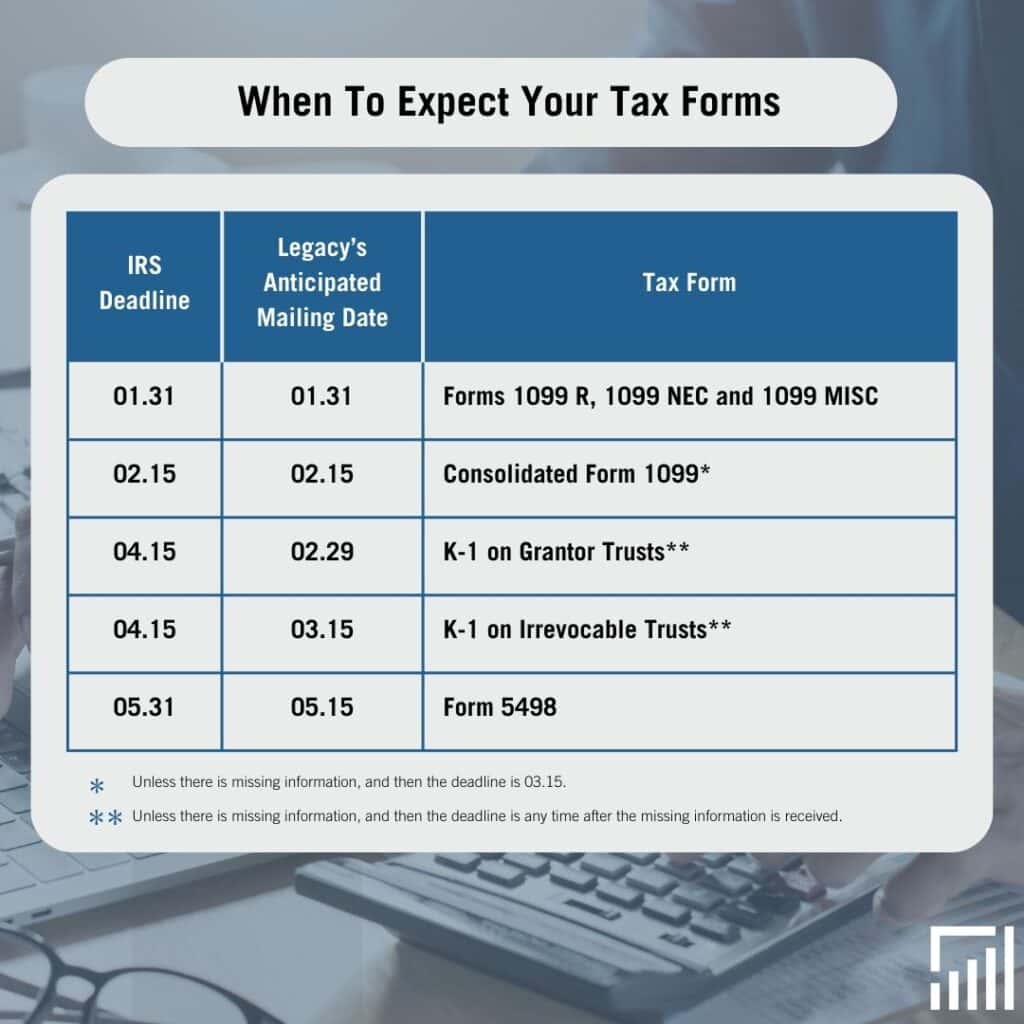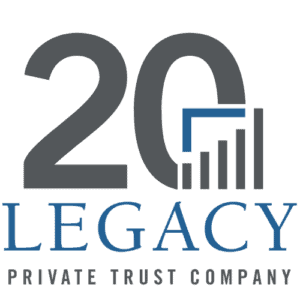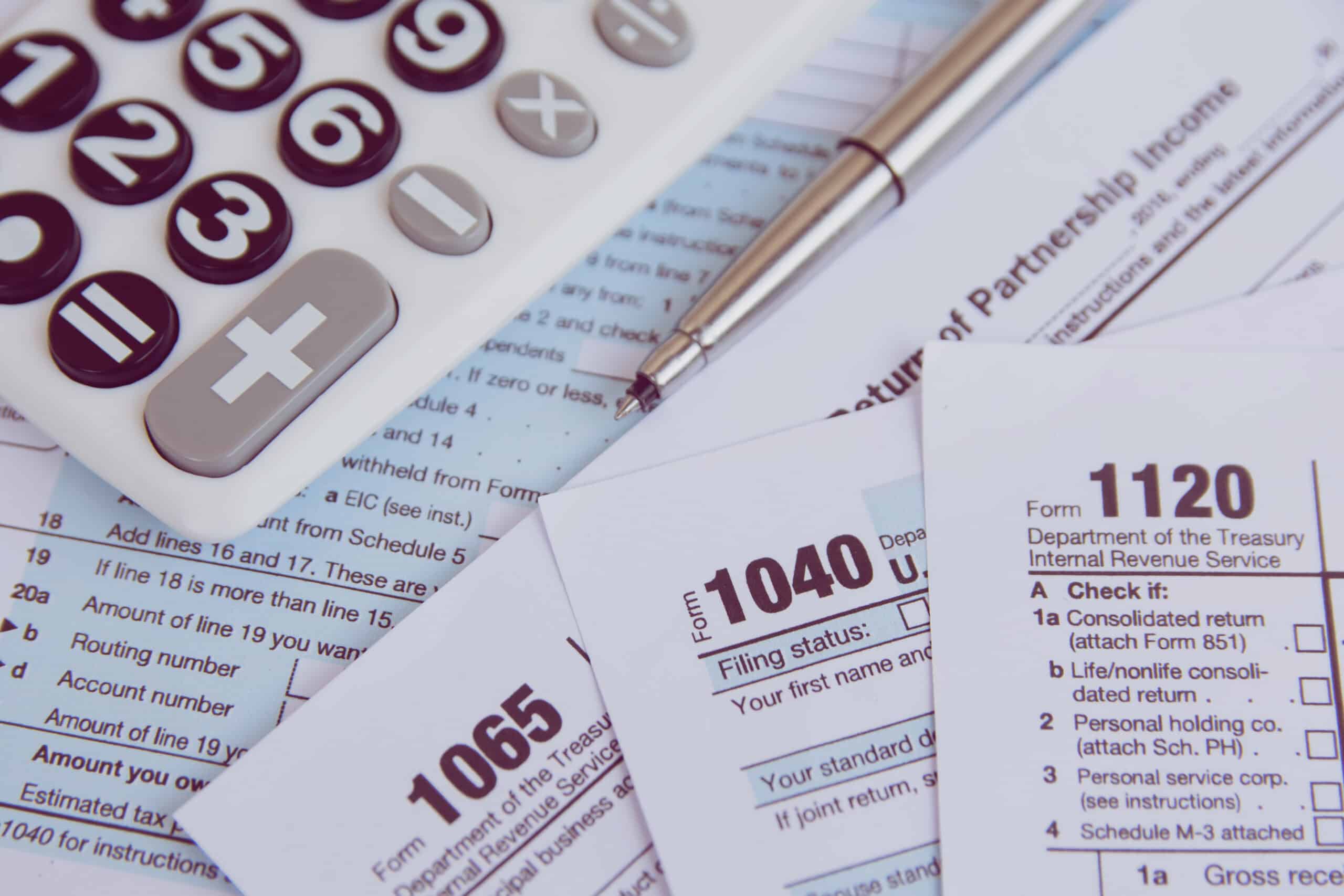As the tax season approaches, it’s important for individuals and businesses alike to stay informed about the distribution deadlines for various tax forms. While many are accustomed to expecting all their tax documents by the end of January, it’s crucial to understand that the deadlines for issuing different tax forms can vary. At Legacy Private Trust Company, we recognize the significance of these deadlines in your financial planning and tax preparation. To assist you, we have compiled a guide outlining the specific sending deadlines for several important tax forms. This information aims to provide clarity and ensure that you have all the necessary documents in a timely manner, helping you to navigate the tax season with ease and confidence.

What is a Form 1099-R?
Form 1099-R is a tax form used to report distributions from pensions, annuities, retirement or profit-sharing plans, IRAs, insurance contracts, and similar vehicles. This form is issued by the plan administrator or institution that manages the retirement plan or account.
Individuals who receive a Form 1099-R must report this information on their federal income tax return. The form helps in determining the tax liability associated with the distributions from retirement accounts and similar financial products. It’s important for taxpayers to understand the implications of these distributions, as they can affect income tax owed and potential penalties for early withdrawal.
When to Expect Your Form 1099-R
The deadline for mailing the tax information for a Form 1099-R is January 31.
What is a Form 1099-NEC?
Form 1099-NEC is a tax form used to report non-employee compensation. This form became widely used starting in the tax year 2020, essentially replacing Box 7 on Form 1099-MISC for reporting payments to non-employees. The “NEC” in Form 1099-NEC stands for “Nonemployee Compensation.”
This form plays a crucial role for both payers and recipients in accurately reporting and taxing non-employee compensation, ensuring compliance with IRS regulations.
When to Expect Your Form 1099-NEC
The deadline for mailing the tax information for a Form 1099-NEC is January 31.
What is a Form 1099-MISC?
Form 1099-MISC is a tax form used to report various types of income other than wages, salaries, and tips (for which Form W-2 is used) and non-employee compensation (for which Form 1099-NEC is used). The “MISC” in 1099-MISC stands for “Miscellaneous.”
This form is used to report payments made in the course of a trade or business to a person who’s not an employee or to an unincorporated business. The IRS requires a Form 1099-MISC for each person to whom a payment is made.
It’s important for businesses to correctly use Form 1099-MISC to report these types of payments. Failure to file this form correctly can result in penalties. For the recipient, this form is important because it provides information that must be reported on their tax return.
When to Expect Your Form 1099-MISC
The deadline for mailing the tax information for a Form 1099-MISC is January 31.
What is a Consolidated Form 1099?
A Consolidated Form 1099 is a comprehensive tax document provided by brokerage firms and investment managers. It combines several types of IRS Form 1099s into one consolidated statement. This form is used to report to the investor and the IRS various types of income, gains, losses, and other transactions that occurred in an investor’s brokerage account during a tax year.
The advantage of the Consolidated Form 1099 is that it provides a comprehensive summary of an investor’s taxable events and income from investments, making it easier to file a tax return. It simplifies tax reporting by consolidating information that might otherwise be reported on multiple separate 1099 forms. Investors typically use this form to report income on their federal income tax return and understand the tax implications of their investment activities.
When to Expect Your Consolidated Form 1099?
The deadline for mailing the tax information for a Consolidated Form 1099 is February 15 unless there are missing information or factors. If there are missing information or factors, the deadline is after February 15 but before March 15.
What is a Schedule K-1?
A Schedule K-1 is a tax form used to report an individual’s share of income, deductions, credits, and other tax items from partnerships, S corporations, estates, trusts, and limited liability companies (LLCs) that are treated as partnerships for tax purposes. Each partner, shareholder, or beneficiary receives a Schedule K-1 from the entity, detailing their share of the entity’s financial activity for the tax year.
Schedule K-1 is essential because it ensures that the income from pass-through entities (like partnerships and S corporations) is taxed at the individual level. The form helps to allocate income, deductions, and credits to the entity’s members based on their proportional share of the entity’s operations. It’s a critical component of the tax reporting process for individuals involved in these types of entities, ensuring the accurate and fair taxation of shared income
When to Expect Your K-1 on Grantor Trusts
Though the official IRS deadline for mailing the tax information for a K-1 on Grantor Trusts is April 15, Legacy will distribute K-1’s by February 29 unless there are missing information or factors. If there are missing information or factors, the deadline is anytime after the missing information is received.
Additionally, if a Grantor Trust needs an extension, Legacy clients will receive a K-1 projection on or before April 15, followed by a final K-1 once the tax return is completed.
When to Expect Your K-1 on Irrevocable Trusts
Though the official IRS deadline for mailing the tax information for a K-1 on Irrevocable Trusts is April 15, Legacy will distribute K-1’s by March 15 unless there are missing information or factors. If there are missing information or factors, the deadline is anytime after the missing information is received.
Additionally, if an Irrevocable Trust needs an extension, Legacy clients will receive a K-1 projection on or before April 15, followed by a final K-1 once the tax return is completed.
What is a Form 5498?
Form 5498 is an IRS tax form used to report contributions to an individual retirement arrangement (IRA), including traditional IRAs, Roth IRAs, SEP IRAs, and SIMPLE IRAs. The form is not filed by the taxpayer but is sent both to the IRS and the taxpayer by the financial institution responsible for the IRA. This form is important for tax records and for ensuring compliance with contribution limits and other IRA-related tax rules.
When to Expect Your Form 5498
The deadline for mailing the tax information for a form 5498 is between May 15 and May 31. This is not needed for filing an individual return.
In conclusion, navigating the complexities of tax season requires an awareness of the various deadlines for receiving different tax forms. As we have outlined, forms such as 1099-R, 1099-NEC, 1099-MISC, Consolidated Form 1099, Schedule K-1, and Form 5498 each have specific mailing deadlines. Understanding these timelines is crucial for effective tax planning and compliance. Legacy Private Trust Company is committed to helping you stay informed and prepared. By keeping track of these key dates and ensuring you have all necessary documents, you can approach tax season with greater confidence and peace of mind. Remember, staying informed and proactive in your tax preparation can significantly simplify the process and help avoid any last-minute challenges.
If you are a Legacy client and have questions, please do not hesitate to contact your Legacy advisor. If you are not a Legacy client and are interested in learning more about our approach to personalized wealth management, please contact us at 920.967.5020 or connect@lptrust.com.
This newsletter is provided for informational purposes only.
It is not intended as legal, accounting, or financial planning advice.




